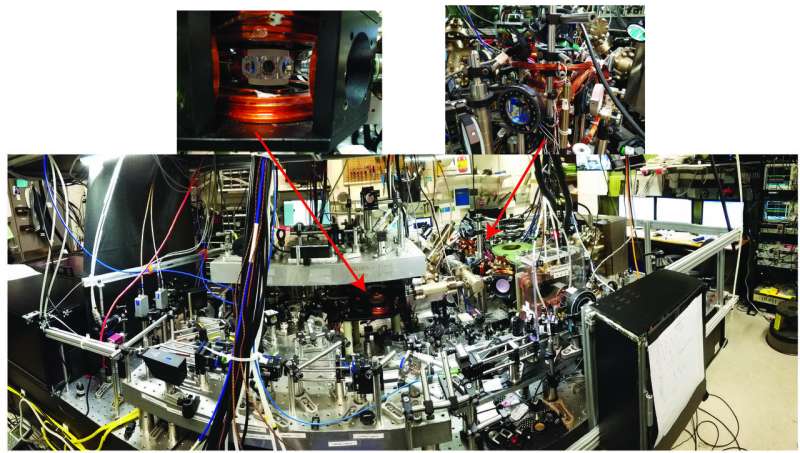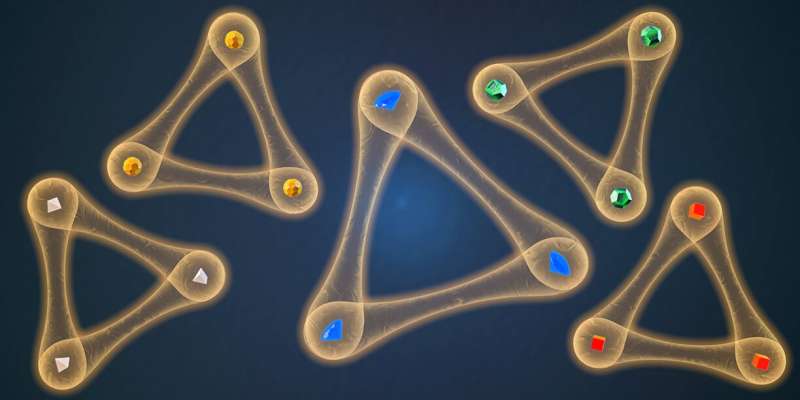January 15, 2020 feature
Precise measurements find a crack in universal physics

The concept of universal physics is intriguing, as it enables researchers to relate physical phenomena in a variety of systems, irrespective of their varying characteristics and complexities. Ultracold atomic systems are often perceived as ideal platforms for exploring universal physics, owing to the precise control of experimental parameters (such as the interaction strength, temperature, density, quantum states, dimensionality, and the trapping potential) that might be harder to tune in more conventional systems. In fact, ultracold atomic systems have been used to better understand a myriad of complex physical behavior, including those topics in cosmology, particle, nuclear, molecular physics, and most notably, in condensed matter physics, where the complexities of many-body quantum phenomena are more difficult to investigate using more traditional approaches.
Understanding the applicability and the robustness of universal physics is thus of great interest. Researchers at the National Institute of Standards and Technology (NIST) and the University of Colorado Boulder have carried out a study, recently featured in Physical Review Letters, aimed at testing the limits to universality in an ultracold system.
"Unlike in other physical systems, the beauty of ultracold systems is that at times we are able to scrap the importance of the periodic table and demonstrate the similar phenomenon with any chosen atomic species (be it potassium, rubidium, lithium, strontium, etc.)," Roman Chapurin, one of the researchers who carried out the study, told Phys.org. "Universal behavior is independent of the microscopic details. Understanding the limitations of universal phenomenon is of great interest."
Due to the few-body nature of interactions in most ultracold systems, researchers must attain a better knowledge of few-particle physics to better understand the complex many-body ultracold phenomena. The team at NIST and CU Boulder honed in on exploring the limits to universality in a few-body universal phenomenon called Efimov physics.
Initially theorized in the context of nuclear physics, this exotic quantum phenomenon predicts that strong two-body interactions can mediate three-body attraction and form weakly bound three-body states called Efimov trimers. In fact, there are an infinite number of Efimov trimers, whose sizes and energies all relate to one another by a universal numerical factor.
In addition to this universal scaling, researchers later noted that in atomic systems, all Efimov trimer sizes are the same (in rescaled units), irrespective of chosen atomic species or of the exact details in the underlying two-body interactions that mediate the three-body forces in Efimov physics. The latter universal aspect of Efimov physics is known as "van der Waals universality," and was deemed true until the recent study.
"The importance of universality in Efimov physics is that we are able to understand and predict the full few-body interaction picture up to arbitrary large length scales, given only broad knowledge of the two-body physics," Chapurin said. "Our measurement shows that this is not always the case, demonstrating the first deviation from van der Waals universality and testing the limits of universal physics in a few-body system."

Chapurin and colleagues performed precise few-body measurements to determine the properties of Efimov trimers in an ultracold potassium gas. The high degree of control over experimental parameters, along with low statistical and systematic errors, allowed them to find the first compelling evidence of non-universal Efimov trimers. The researchers discovered Efimov trimers with sizes that are significantly larger than what the universal theory predicts.
"Our measurements, with unprecedented precision, revealed a surprising result: the first definitive deviation from van der Waals universality," Chapurin said. "We measured Efimov trimer sizes to be different from what universal theory predicts and different from all previous measurements in different atomic species."
To better understand their observations, the researchers developed a new three-body theoretical model. Their model suggests that in rare circumstances, the microscopic/fine details in the problem (in this case, the complex spin interactions) can drastically affect macroscopic observables such as the size of the Efimov trimers.
"We found that a refined three-body model based on our precise measurements of two-body interactions, arguably the most accurate measurement of two-body physics in an ultracold system, can account for the observed nonuniversal result," Chapurin explained. "In this rare occurrence, the fine and complex microscopic details of interactions crack the universal nature of Efimov physics."
Although experimental observations clearly point to a strong deviation from van der Waals universality, "not all that is universal is lost," according to Jose D'Incao, also a researcher in the study. He added that: "one of the premises of universality still persist: by only knowing how two atoms interact, all low energy properties of Efimov triatomic systems can be derived, without the need to refer to the more traditional and complicated three-body chemical forces."
The study carried out by Chapurin and colleagues gathered new fascinating observations that could enhance the current understanding of universality in few-body physics. Although the researchers were able to provide a tentative explanation, many questions remain unanswered.
For instance, while their paper offers insight for the observed deviation from universality of the first Efimov state, the effect of such complex microscopic physics on the consecutive Efimov states (in the infinite Efimov series) is still an open question. Studies of these weakly bound consecutive states require ever colder temperatures (less than one billionth of a degree above the absolute zero) that are best attained in a microgravity environment. The team, who is part of the larger JILA collaboration, hope to address this question by performing future experiments in the Cold Atom Laboratory on the International Space Station.
More information: Roman Chapurin et al. Precision Test of the Limits to Universality in Few-Body Physics, Physical Review Letters (2019). DOI: 10.1103/PhysRevLett.123.233402
University of Colorado Boulder: jila.colorado.edu/
Journal information: Physical Review Letters
© 2020 Science X Network




















